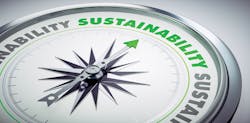As momentum grows for legislative action to spur recycling of packaging and tax virgin resin, advocates and opponents of particular regulatory approaches issued varying views on the implications for two interests: Jobs and sustainability.
“If we don’t find a way, governments and such will mandate it to happen, so we can either be in control of our destiny, or have it controlled for us. So, I think the industry as a whole needs to step up,” said Michael Sansoucy, director of packaging, sales and applications for Arburg.
“I think this is kind of the misconception that the industry is not willing to accept any type of regulation,” Seaholm said, “because ... the Plastics Industry Association in particular, we can support funding for recycling infrastructure, recycled-content requirements, and certainly labeling is something that, we want appropriate and the best labeling to be on products, as well.”
EPR approaches come to packaging
Among the newest trends in regulatory approaches to plastics is a decades-old strategy with a relatively new target: packaging.
Originally designed for hard-to-discard consumer goods, including batteries, paint and mattresses, EPR legislation imposes fees at the inception of a product’s life to account for the costs of its inevitable demise.
In all, 33 states have EPR laws governing products from thermostats to medical sharps.
Maine kicked off the EPR trend with lawmakers’ passage of Legislative Document (LD) 1541, which Democratic Governor Janet Mills signed in July. According to bill sponsor Maine Rep. Nicole Grohoski (D-Ellsworth), it aims to reduce plastic waste by creating a support structure for currently overburdened municipal waste facilities.
Like materials recovery facilities (MRFs) elsewhere in the country, Maine’s MRFs are facing financial pressures that disincentivize recycling. The state’s Department of Environmental Protection has found the cost to recycle waste in the state is 67 percent higher than landfilling it.
In raising money for recycling, the state is acknowledging the service as a public good, Grohoski said.
“There are plenty of systems we fund that do not make a profit but are a benefit to society. I wouldn't use the term subsidize to talk about roads, fire and police, schools, etc. Municipal recycling programs were not intended to be profit centers, but it does happen to be that some materials are valuable, so that is a plus,” she said. “One could say that right now, municipal taxpayers are subsidizing corporations who have shifted the cost burden of managing the direct-to-consumer packaging they produce which municipalities have no say over.”
With LD 1541, Maine has reassigned that burden, Grohoski said.
She believes the onus for cleaning up packaging waste should be borne by the manufacturers who’ve produced the materials.
“The law applies the polluter-pays principle. It puts the responsibility of paying for waste management where it belongs — on the producers of the waste, shifting it away from municipal taxpayers,” she said.
In its June Hopper newsletter, PLASTICS dismissed the new EPR law in Maine, as well as one that became law in Oregon several weeks later, as “tax-and-spend bureaucratic regulatory schemes.”
“Both Maine and Oregon have essentially created new government agencies to dictate how this massive amount of new tax money is used. Producers will not have control over the money,” the newsletter article states.
Seaholm voiced frustration in the process that resulted in LD 1541.
“The industry and a lot of stakeholder groups were involved in trying to craft an Extended Producer Responsibility bill, and I will tip my cap to AMERIPEN [American Institute for Packaging and the Environment] — AMERIPEN really led the effort up there to try to get a competing bill to the one that was being proposed by the environmental activist organizations in that state,” he said. “And a ton of work went into it, a ton of input. It got introduced, it had a hearing the same day as the other one, and, then, the industry was essentially told, ‘Yeah, we're not even going to bother trying to amend your bill, we’re just going to go with other one.’”
Seaholm said he believes compromise is possible, but politics is getting in the way.
“I mean, the problems that are trying to be solved, are actually solvable. And, if both sides could actually pull politics out of it, I think a lot of these issues would be solved, but there are other dynamics at play there.”
In defense of plastics
Industry groups, including PLASTICS, argue that packaging is not the problem. The issue, they say, is with improperly discarded waste.
Recently, PLASTICS took aim at a report released by an anti-plastics environmental group called Beyond Plastics, which blames the materials for contributing to climate change.
PLASTICS argued that, because they weigh less than many other materials, plastics require less fuel for transport, giving them a lighter environmental footprint. Its press release states:
“Additionally, if plastic packaging were replaced with other materials, waste and energy consumption would double, and weight and costs would quadruple. For example, plastic baby food packaging provides small but significant environmental benefit over glass jars with impacts reduced by 14 percent to 27 percent for primary energy and 28 percent to 31 percent for global warming. When comparing plastic and glass baby food jars, plastic containers also release fewer carcinogens into the air and send fewer pollutants into waterways when compared to glass jars.”
Advocating for more regulations
Competing interests and causes have sparked debate over the path forward.
While PLASTICS is supportive of investment in recycling infrastructure, including chemical recycling and pyrolysis facilities, groups outside the industry are searching for ways to eliminate the manufacture of some plastic goods — including packaging — altogether.
“Whether we bury it, or burn it, or dump it in the ocean, it’s going to come back, and it is coming back to haunt us in innumerable ways. … The first thing we’ve got to do is we’ve got to figure out ways to eliminate the single use of really anything,” said Thomas Oppel, the executive VP for the American Sustainable Business Council (ASBC).
With more than 250,000 associations and companies, with such big names as Ben & Jerry’s, Seventh Generation, Lego and Etsy, the ASBC lobbies for policies that reflect what it calls a “triple bottom line” — people, planet and profit.
To environmentalists’ usual three Rs — reduce, recycle and reuse — Oppel adds a fourth: rethink. He believes addressing plastic waste demands an openness to considering an array of solutions — repurposing end-of-life goods, cutting down on packaging, investing in recycling, opting for refillables over disposables, and researching new materials that don’t require fossil-fuel derivatives.
“It should be about reducing the amount of materials to begin with, and then certainly reducing, ultimately eliminating, toxic materials … and ultimately moving us toward that circular economy where materials that are produced for one purpose can be repurposed, so that, instead of having to be buried or burned, they can be reused,” he said.
To Oppel, the plastics industry imposes unaccounted-for costs upon the environment and economy that demand a reckoning.
“What we need to be moving toward is full cost accounting, an understanding of what does it really cost, in terms of producing, distributing, disposing of a product or a service?” Oppel said. “In times past, for example, a coal plant operator would say, ‘Well, if I have to put scrubbers on my plant, on my smokestacks, it’s going to cost me X. That’s way too expensive; I can’t afford it.’ And he calculates that based on his expenses to run his facility, and the profit he is making. What he doesn’t calculate is the cost of the health impacts downwind from that coal plant.”
Taxing times
While EPR legislation has been proposed in a slew of states, especially in places where Democratic lawmakers hold sway in either the statehouse or governor’s mansion, or both, the mechanism is just the latest wrinkle in efforts to change behavior.
A more traditional approach — taxes — has PLASTICS’ full attention.
The trade organization has been vociferous in opposing the Rewarding Efforts to Decrease Unrecycled Contaminants in Ecosystems (REDUCE) Act, which would levy a 20-cent tax on every pound of virgin resin bound for use in certain types of single-use products, including packaging, by 2024.
PLASTICS characterizes the resin tax, sponsored by Sen. Sheldon Whitehouse (D-Rhode Island), as punitive and counter-productive.
“My understanding of the proposal [in the REDUCE Act] is that the resin tax will be collected from resin manufacturers and could be passed down the supply chain. This increases the cost of business and puts over 150,000 manufacturing jobs at risk,” PLASTICS chief economist Perc Pineda wrote in a column that appeared in the October issue of Plastics Machinery & Manufacturing.
In a letter sent to all members of Congress, more than 60 businesses and trade associations connected to the plastics industry spoke out. They included packaging makers Westfall Technik, Fabri-Kal and Pactiv-Evergreen, as well as machinery OEMs Leistritz, Frigel, Yushin, Absolute Haitian and others.
“We are committed to increasing the amount of recycled plastic and support reasonable measures to encourage its use. Unfortunately, simply slapping a new tax on virgin resin and expecting significant change ignores the fact that the supply of recycled plastic is limited — especially for food-contact applications. That supply constraint would make this tax unavoidable and mean billions in higher costs for our customers, tighter margins across the industry, and safe to assume tens of thousands of manufacturing jobs will be lost,” the letter states.
Like Pineda, ASBC’s Oppel believes laws designed to support sustainability could produce collateral impacts on the economy. But he doesn’t think those impacts have to be negative.
“The argument is, OK, if we can recycle plastic, why do we need to create more virgin plastic? Because in creating virgin plastic, we are contributing to the amount of plastic that’s in the environment, and the amount of toxins because of the creation of plastic that get put into the environment,” he said.
He said he believes that efforts to develop new, non-fossil-fuel-based materials could actually result in new jobs, as well as a more environmentally friendly economy.
“Can we change the kind of materials we’re using? That may create more jobs, in terms of how we’re doing it. And can we change how we distribute the product and service, which also may create more jobs, or new jobs?” Oppel asked.
Creating a recycled-content market
Alongside efforts to curb the use of one-time-use plastics and virgin resin is a trend toward imposing minimum standards for the use of recycled resin.
For example, Washington Senate Bill 5022, signed in May by Governor Jay Inslee, sets a baseline for beverage, cleaning and personal-care containers, and plastic bags, with standards varying according to product type and timetable, ranging from minimums of 15 percent to 50 percent over the next 15 years.
New Jersey Senate Bill 2515 (S2515) is “by far the most aggressive” of the minimum-content-standards proposals, Seaholm said, as “it covers all rigid plastic containers under 5 gallons, which is a massive, massive amount of products that would fall into that category.”
Among its provisions, the bill sets standards for the use of virgin and recycled content in a number of products, including rigid plastic and beverage containers. For example, it would require that the makers of rigid plastic containers use either plastic that is recycled within the state at a rate of 35 percent, or recycled content that makes up at least 35 percent of the composition of the containers. Recycled-content minimums for drink containers would increase over time, eventually hitting 50 percent in 2031.
In addition, the bill includes a ban on PS loose-fill packaging.
Recycled-content requirements help shape a more circular economy, proponents say.
“We need to remember that we need to look at eliminating the packaging we don’t need, innovating the packaging we use, but also the business model, the delivery models and the products that we place in the market. And, then, last but not least, ensuring [we’re] circulating the material in the market,” said Ambrogio Miserocchi, senior policy officer for the Ellen MacArthur Foundation, a U.K. organization dedicated to working toward a circular economy.
Key to some of the EPR and recycled-content bills is an understanding of definitions. Who determines what materials are “recyclable,” or what “compostable” means?
Seaholm noted that the industry itself is trying to settle on definitions.
On the national level, he believes that one bill that provides a good framework is the Plastic Waste Reduction and Recycling Research Act (HR 2821) introduced in the spring by Rep. Haley Stevens (D-Michigan). It would support research into new materials and technologies for recycling products including food-grade packaging. Implementation of some aspects would involve collaboration with an array of stakeholders, including packaging manufacturers’ groups.
“It has a lot of important things included in it, especially when it comes to standards and definitions, and providing a direction and standards at a federal level would certainly help because we play a little bit of a game of whack-a-mole when it goes from state to state, and different policies are being proposed,” Seaholm said.
While PLASTICS supports some labeling requirements, the organization is skeptical of others, Seaholm said.
“Unfortunately, what we saw with the truth-in-labeling-type bills is it was being used as a backdoor way to ban products, by setting unrealistic goals or requirements for the amount of product that actually gets recycled, and, if you don't meet that threshold that they are creating, then you can’t market your product as recyclable,” Seaholm said.
The current infrastructure and levels of available feedstock could be inadequate to meeting some targets, Seaholm said. He warned, for example, that S2515’s standards “are very difficult to meet, probably impossible to meet, based on the current infrastructure that exists.”
“I was at a recycling facility a few weeks ago, and I asked, ‘Is there anything stopping you from expanding?’ And the answer was, ‘The only thing stopping us from expanding is the availability of the feedstock. We can’t get enough material to recycle,’ ” he recalled.
Investing in infrastructure
While where the money for infrastructure comes from is a source of contention, where it should go carries the potential for some agreement between industry and environmental advocates.
Seaholm isn’t alone in believing the current infrastructure isn’t up to the task of keeping plastic in the economy and out of landfills.
“Many residents want to recycle but just don’t have the option to,” said Grohoski, who pushed for the EPR program in Maine.
To bolster recycling capacity, PLASTICS — along with a host of other industry insiders, including AMERIPEN, the Flexible Packaging Association and the Foodservice Packaging Institute — backs the Realizing the Economic Opportunities and Values of Expanding Recycling (RECOVER) Act, sponsored by Reps. Tony Cárdenas (D-California) and Larry Bucshon (R-Indiana). It also supports the Recycling Enhancements to Collection and Yield through Consumer Learning and Education (RECYCLE) Act.
If passed, the RECOVER and RECYCLE acts would provide $500 million and $75 million over several years, respectively, to expand and improve infrastructure and programs for recycling products, including packaging. Among other measures, the bills would help fund programs to educate consumers about recycling.
In addition, Seaholm said PLASTICS supports some aspects of the infrastructure bill, which is currently stalled in the U.S House of Representatives, after being approved by the U.S. Senate in August.
“One thing that is great about the bipartisan infrastructure deal is it includes $275 million for Save our Seas 2.0 priorities. This is another bill that we’ve supported, and it includes $75 million, as part of the RECYCLE Act that got included, [for] grants to state and local governments to help consumer education as well as businesses recycle more … as well as improved collection,” he said.
With many state and national lawmakers looking ahead to elections next year, Seaholm foresees a busy legislative agenda.
“I think the industry has accepted that, ‘Yeah, we’ve got a role to play in this solution,” he said.
In the best-case scenario, he hopes for laws that set goals for the plastics industry, fund recycling infrastructure and provide for safeguards to protect jobs.
“There are a lot of conversations happening behind the scenes between industry and elected officials to try to come up with workable solutions that industry can perhaps support but at least live with, that isn’t meant to be a punitive measure towards packaging and maybe plastic as a material, but actually more of a collaboration that solves the problems,” he said. “I hold a little bit of cautious optimism, that there might be some bills passed next year that we look at and say, ‘You know what? This is the model that other states should look at.’ ”
At the same time, he worries about actions that might shift costs back to the industry.
“I think,” he said, “you’re going to see some states that have good stuff and some states that have some bad stuff.”
For more information:
American Sustainable Business Council, Washington, 202-660-1455, https://www.asbcouncil.org/
Ellen MacArthur Foundation, Cowes, England, https://ellenmacarthurfoundation.org
PLASTICS, Washington, 202-974-5200, www.plasticsindustry.org
Karen Hanna | Senior Staff Reporter
Senior Staff Reporter Karen Hanna covers injection molding, molds and tooling, processors, workforce and other topics, and writes features including In Other Words and Problem Solved for Plastics Machinery & Manufacturing, Plastics Recycling and The Journal of Blow Molding. She has more than 15 years of experience in daily and magazine journalism.
High-tech skills come at high price
So, you need a new ERP. Now what?









